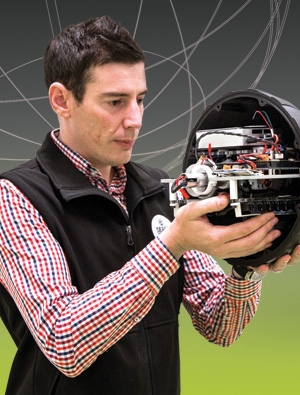VR CAVE ushers in a virtual future for engineering
Research news
Walking inside a virtual jet engine to “see” potential design flaws is just one possibility offered by the virtual reality (VR) CAVE within Deakin’s new state-of-the-art engineering facility.
Being inside a Cave Automated Virtual Environment (CAVE) is like nothing else, explained Deakin mechatronics expert, Dr Ben Horan, who designed the lab.
“Imagine being inside a twenty-five cubic metre area where you are surrounded by 3D virtual reality and you can see, hear and touch everything in the environment. Users will be able to move around and through models of new designs, such as machinery, prototypes, buildings, or even human scenarios, at any scale, depending on the nature of the project.”
“The potential applications of this technology are only limited by our imaginations,” enthused Dr Horan.
The VR CAVE will be based within the Centre for Advanced Design in Engineering Training (CADET), which is to be launched at the Waurn Ponds campus this year. It is set to offer some of the best future-focused engineering and design facilities in any Australian university - and the most advanced in regional Australia.
A partnership between Deakin University and the Australian Government, CADET will feature more than $6 million worth of cutting edge technologies and specialist learning aids - representing the pinnacle of engineering education within Australia.
Focused on digital manufacturing, rapid prototyping, 3D printing, modelling and visualisation technologies, CADET will enable students, researchers and industry to experience and master the tools and techniques that will create the next generation of Australian manufacturing.
It will also link secondary, VET and tertiary education through special on-campus programs that will help to build aspirations for a career in the industry.
Dr Horan explained that the VR CAVE will complement a suite of high tech simulation labs at Deakin, including the Motion.Lab, which focusses on human motion, and the Universal Motion Simulator, which allows researchers to study high speed scenarios, particularly in the design space and in collaboration with aerospace, defence and automotive industries.
“What makes our CAVE unique is that we have designed it to be versatile enough to support a wide range of research applications through the integration of an array of cutting edge technologies,” he said.
“The VR CAVE offers high realism and high resolution. It is totally immersive, with full peripheral vision. For instance, you could be physically exploring the inside of an aircraft design and not only be able to visualise in high resolution 3D vision, but, through haptics technology, be able to use your hands to touch and feel the various components of the aircraft interior - all before the creation of any physical prototype.”
Technologies such as virtual reality and 3D scanning are currently transforming design and construction processes, he explained, allowing creative design solutions to be developed almost seamlessly from imagination, to reality, to manufacture, in a single journey.
“Instead of computer aided design, for instance, engineers and designers can now use 3D scanners to scan in existing products and then refine the design within immersive virtual reality to create virtual prototypes, without the expense of manufacturing them,” he said.
“The potential applications for the technology are endless, whether it be training operators how to work in hazardous environments, such as bushfires, from the safety of the CAVE, training technicians to assemble new devices, helping aerospace engineers to design aircraft parts, or allowing walk-throughs of yet-to-be constructed buildings.”
“We are looking forward to working closely with industry partners to explore the potential of this technology and help develop new commercial opportunities.”
Share this story
 Mechatronics expert Dr Ben Horan has designed CADET's new VR cave.
Mechatronics expert Dr Ben Horan has designed CADET's new VR cave.
